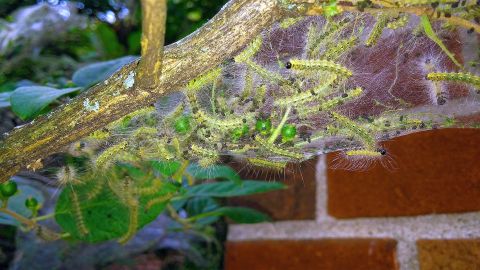
When someone perpetrates a series of crimes, TV police closely consider the “Perp’s” modus operandi, or method of operation. This is of some value in understanding the thinking of the criminal so they can better identify him or perhaps anticipate his next victim.
Another person might choose to commit a crime using the same modus operandi so his crime will be blamed on the serial criminal. That way he, this other person, will not be held accountable for the crime he committed. He is said to be a copycat criminal. Law enforcement is only too well acquainted with the copycat.
Let’s Take to the Trees
I questioned my 10-year old granddaughter to see if she knew when in the year “tents” began to appear in certain trees – translucent white tents that were filled with developing caterpillars, hundreds, perhaps thousands of them. She said, “Isn’t it late Spring or early Summer?” I answered in the affirmative. Then I asked her what the name of those caterpillars were? She did not know. I answered Eastern tent caterpillars. Latin name, Malacosoma americanum.
However, that was not the only name for them. They are sometimes called the Spring webworm.
Copycaterpillars
In the late Summer1, other tents show up in trees, some of them of considerable size. They are white to light tan and are sometimes of considerable size, occasionally encompassing an entire tree. In addition, the tents may incorporate dead, or dying, leaves within them – sometimes even broken branches.
Those rascally webworms. But they are NOT Eastern tent caterpillars. They are the so-called Fall webworm, Hyphantria cunea. Notice the difference in the names. The appearances of the mature moths, while not astounding, are obviously different as to color.
Spring webworms are tan, with two creme-color stripes. Fall webworms are white, often flecked with dark gray.
Webworms: Other Differences
Eastern tent caterpillars are dark colored with a thin white stripe, with modest tufts of hair along its sides, whereas Fall webworms exhibit a variety of white, yellowish, or another light colors and are extremely hairy!
The Eastern tent caterpillar builds its tent in the forks of branches. The Fall webworm is not so selective. In addition, Fall webworm nests are, well, messy.
Unlike certain imports such as the Gypsy Moth or the Stink Bug, there are many “natural enemies” of the Fall webworm. Hence, intervention by humans is seldom required.
Although Fall webworms invade a large variety of trees, Spring webworms are much more selective. On the other hand, they apparently have fewer natural enemies.
Removing tents of the Eastern tent caterpillar during the early stages (perhaps squishing the little critters, if you’re like me) is an effective way to eliminating caterpillars from small trees.
1 Although the tents appear in late summer, the eggs may be laid as early as the latter part of June.
Note: You might also enjoy Eastern Tent Caterpillar Dissertation
References: